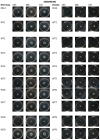Virulence of Pseudomonas aeruginosa in Cystic Fibrosis: Relationships between Normoxia and Anoxia Lifestyle
- PMID: 38275311
- PMCID: PMC10812786
- DOI: 10.3390/antibiotics13010001
Virulence of Pseudomonas aeruginosa in Cystic Fibrosis: Relationships between Normoxia and Anoxia Lifestyle
Abstract
The airways of cystic fibrosis (CF) patients are colonized by many pathogens and the most common is Pseudomonas aeruginosa, an environmental pathogen that is able to infect immunocompromised patients thanks to its ability to develop resistance to conventional antibiotics. Over 12% of all patients colonized by P. aeruginosa harbour multi-drug resistant species. During airway infection in CF, P. aeruginosa adopts various mechanisms to survive in a hostile ecological niche characterized by low oxygen concentration, nutrient limitation and high osmotic pressure. To this end, P. aeruginosa uses a variety of virulence factors including pigment production, biofilm formation, motility and the secretion of toxins and proteases. This study represents the first report that systematically analyzes the differences in virulence features, in normoxia and anoxia, of clinical P. aeruginosa isolated from CF patients, characterized by multi- or pan-drug antibiotic resistance compared to antibiotic sensitive strains. The virulence features, such as biofilm formation, protease secretion and motility, are highly diversified in anaerobiosis, which reflects the condition of chronic CF infection. These findings may contribute to the understanding of the real-world lifestyle of pathogens isolated during disease progression in each particular patient and to assist in the design of therapeutic protocols for personalized medicine.
Keywords: antimicrobial resistance; biofilm; motility; oxygen concentration; proteases; pyocyanin; pyoverdine.
Conflict of interest statement
The authors declare no conflict of interest.
Figures











References
LinkOut - more resources
Full Text Sources

